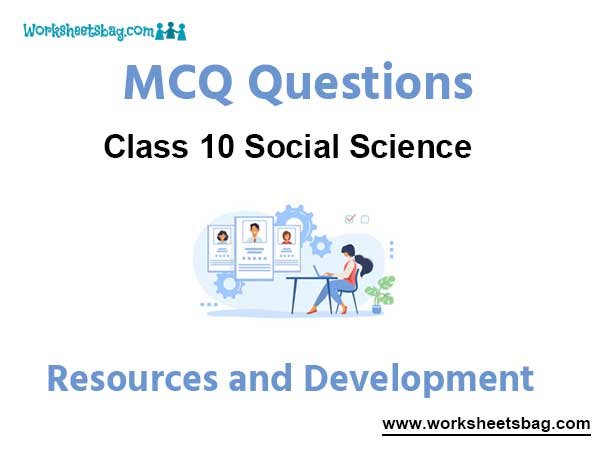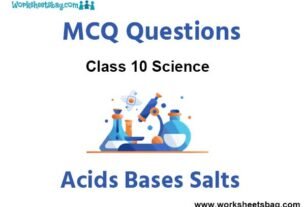Please refer to Resources and Development MCQ Questions Class 10 Social Science below. These MCQ questions for Class 10 Social Science with answers have been designed as per the latest NCERT, CBSE books, and syllabus issued for the current academic year. These objective questions for Resources and Development will help you to prepare for the exams and get more marks.
Resources and Development MCQ Questions Class 10 Social Science
Please see solved MCQ Questions for Resources and Development in Class 10 Social Science. All questions and answers have been prepared by expert faculty of standard 10 based on the latest examination guidelines.
MCQ Questions Class 10 Social Science Resources and Development
Question. Jute requires
(a) Heavy rainfall
(b) Alluvial soil
(c) High temperature
(d) All of the options
Answer
D
Question. The leading producer of jute is
(a) India
(b) Myanmar
(c) Bangladesh
(d) Pakistan
Answer
A
Question. The suitable condition for production of coffee is (are)
(a) Hill slopes
(b) Warm and wet climate
(c) Well drained loamy soil
(d) All of the options
Answer
D
Question. Which of the following comes under primary activities?
(a) Agriculture
(b) Manufacturing
(c) Transportation
(d) None of the options
Answer
A
Question. Which country has no known mineral deposits?
(a) Netherlands
(b) Hungry
(c) Austria
(d) Switzerland
Answer
D
Question. Silicon, used in the computer industry is obtained from
(a) Bauxite
(b) Quartz
(c) Cuprite
(d) Magnetite
Answer
B
Question. Bauxite is an ore of
(a) Copper
(b) Iron
(c) Aluminium
(d) Mica
Answer
C
Question. Petroleum means
(a) Rock oil
(b) Land oil
(c) Black oil
(d) Shell oil
Answer
A
Question. Bio-gas is primarily a mixture of
(a) Methane and Oxygen
(b) Methane and carbon dioxide
(c) Propane and carbon dioxide
(d) Propane and oxygen
Answer
B
Question. Viticulture is
(a) Rearing of silk worms
(b) Growing vegetables
(c) Breeding of fish
(d) Cultivation of grapes
Answer
D
Question. The following is also known as Golden fibre.
(a) Wool
(b) Cotton
(c) Jute
(d) Silk
Answer
C
Question. Cotton requires
(a) High temperature, light rainfall
(b) Low temperature, light rainfall
(c) High temperature, high rainfall
(d) Low temperature, high rainfall
Answer
A
Question. The largest producer of rice in the world is
(a) China
(b) India
(c) Japan
(d) Indonesia
Answer
A
Question. A natural area designated to protect the ecological integrity of one or more ecosystems for present and future generations, is called
(a) National park
(b) Biosphere reserve
(c) Bird sanctuaries
(d) Wildlife sanctuaries
Answer
B
Question. A naturally occurring substance that has a definite chemical composition is a
(a) Rock
(b) Compound
(c) Metal
(d) Mineral
Answer
D
Question. The largest producer of mica in the world is
(a) India
(b) Australia
(c) China
(d) Canada
Answer
A
Question. Kolar in has deposits of gold in India
(a) Karnataka
(b) Tamil Nadu
(c) Kerala
(d) Andhra Pradesh
Answer
A
Question. Silicon, used in the computer industry is obtained from
(a) Cuprite
(b) Bauxite
(c) Quartz
(d) Magnetite
Answer
C
Question. The following is (are) non-metallic mineral(s)
(a) Gypsum
(b) Limestone
(c) Mica
(d) All of the options
Answer
D
Question. Minerals that lie at shallow depths are taken out by removing the surface layer; this is known as
(a) Shaft mining
(b) Open-cast mining
(c) Drilling
(d) All of the options
Answer
B
Question. Non-metallic minerals are found in
(a) Sedimentary rocks
(b) Igneous rocks
(c) Metamorphic rocks
(d) All of the options
Answer: Sedimentary rocks
Answer
A
Question. The major factor(s) of soil formation is (are)
(a) Time taken for the composition of soil formation
(b) The nature of the parent rock
(c) Climatic factors
(d) All of the options
Answer
D
Question. is leading producer of copper.
(a) Chile
(b) Peru
(c) Argentina
(d) Brazil
Answer
A
Question. Coal, iron ore, petroleum, diesel etc. are the examples of
(a) Biotic resources
(b) Abiotic resources
(c) Renewable resources
(d) Non Renewable resources
Answer
D
Question. Which one of the following term is used to identify the old and new alluvial respectively ?
(a) Khadas & Tarai
(b) Tarai & Bangar
(c) Bangar & Khadar
(d) Tarai & Dvars
Answer
A
Question. Which type of soil develops due to high temperature and evaporation ?
(a) Arid Soil
(b) Forest Soil
(c) Black Soil
(d) Red Soil
Answer
A
Question. Which one of the following resources can be acquired by the Nation ?
(a) Potential resources
(b) International resources
(c) National resources
(d) Public resources
Answer
C
Question. Which one of the following is responsible for sheet erosion ?
(a) Underground water
(b) Wind
(c) Glacier
(d) Water
Answer
D
Question. Which one of the following method is used to break up the force of wind?
(a) Strip Cropping
(b) Shelter belt
(c) Contour ploughing
(d) Terrace farming
Answer
B
Question. Which one of the following soil is the best for cotton cultivation ?
(a) Red soil
(b) Black soil
(c) Laterite soil
(d) Alluvial soil
Answer: Black soil
Answer
B
Question. How much percentage of forest area in the country according to the National Forest Policy.
(a) 33%
(b) 37%
(c) 27%
(d) 31%
Answer
A
Question. The first country in the world to develop hydroelectricity is
(a) Norway
(b) China
(c) England
(d) USA
Answer
A
Question. has the worlds largest geothermal power plants
(a) Canada
(b) Australia
(c) China
(d) USA
Answer
D
Question. The first tidal energy station was built in
(a) Portugal
(b) Spain
(c) France
(d) Denmark
Answer
C
Question. Minerals can be extracted by
(a) Quarrying
(b) Mining
(c) Drilling
(d) All of the options
Answer
D
Question. Which of the following country is largest producer of coal?
(a) China
(b) India
(c) USA
(d) Australia
Answer
A
Question. Series of protected areas linked through a global network, intended to demonstrate the relationship between conservation and development, is called
(a) National park
(b) Biosphere reserve
(c) Bird sanctuaries
(d) Wildlife sanctuaries
Answer
B
Question. The following is called Black gold.
(a) Petroleum
(b) Coal
(c) Bauxite
(d) None of the options
Answer
A
Question. China also leads in production of
(a) Tungsten
(b) Lead
(c) Antimony
(d) All of the options
Answer
D
Question. The following is the worlds leading tin producer
(a) China
(b) Malaysia
(c) Indonesia
(d) India
Answer
A
Question. The following is the worlds leading iron-ore producer
(a) India
(b) Russia
(c) France
(d) China
Answer
D
Question. What is area sown more than once in an agriculture year plus net sown area known as?
(a) Permanent pastures
(b) Fallow lands
(c) Net sown area
(d) Gross cropped area
Answer
C
Question. Black soil is also known by which of the following names?
(a) Bangar
(b) Khadar
(c) Regur
(d) Laterite
Answer
D
Question. Which of the following resource is non-recyclable ?
(a) Coal
(b) Iron-ore
(c) Copper
(d) Gold
Answer
A
Question. Which are the main factors that determine creation of a resource ?
(a) Nature and technology
(b) Nature and human being
(c) Nature, human beings and technology
(d) Technology
Answer
C
Question. Which among the following is a type of resources classified on the basis of exhaustibility ?
(a) Biotic and abiotic
(b) Renewable and non renewable
(c) National and individual
(d) Potential and reserves
Answer
D
Question. Which of the following method will not help in soil conservation?
(a) Contour ploughing
(b) Strip cropping
(c) Creating shelter belts
(d) Ploughing up and down the slopes
Answer
D
Question. On the basis of ownership, plantations can be better considered as which of the following types of resources?
(a) Individual resource
(b) Community owned resource
(c) National resource
(d) International resource
Answer
A
Question. How can the resources be classified on the basis of their origin?
(a) Biotic and Abiotic
(b) Renewable and Non- renewable
(c) Individual and Community
(d) Potential and Reserves
Answer
B
Question. Which one of the following is not the Community Owned Resource ?
(a) Grazing grounds
(b) Burial grounds
(c) Village pond
(d) Privately owned house
Answer
C
Question. The oceanic resources beyond 200 km of the Exclusive Economic Zone can be termed as which of the following types of resource ?
(a) Individual resources
(b) Community owned resources
(c) National resources
(d) International resources
Answer
B
Question. Which of the following soils are more common in piedmont plains such as Duars, Chos and Terai?
(a) Black soil
(b) Alluvial soil
(c) Laterite soil
(d) None of these
Answer
B
Question. Which of the following is not a measure to reduce soil erosion?
(a) Creating deep channels (gullies)
(b) Contour ploughing
(c) Strip cropping
(d) Planting of shelter belts
Answer
A
Question. The Rio Convention endorsed the Global Forest Principles and adopted which of the following for achieving Sustainable Development in the 21st century?
(a) Agenda 21
(b) Agenda 22
(c) Agenda 20
(d) Agenda 25
Answer
A
Question. Indiscriminate exploitation of resources has led to global ecological crises. Which of the following is NOT associated to this statement?
(a) Global warming
(b) Ozone layer maintenance
(c) Environmental pollution
(d) Land degradation
Answer
B
Question. Resources which are found in a region, but have not been utilised are called ………………… .
(a) Potential
(b) Developed
(c) Stock
(d) Reserve
Answer
A
Question. Which one of the following is an example of Cultivable Wasteland?
(a) Gross cropped Area
(b) Uncultivable Land
(c) Barren Wasteland
(d) Current fallow Land
Answer
B
Question. The village of Sukhomajri and the district of Jhabua have shown that it is possible:
(a) To reverse land degradation
(b) To reverse economic prosperity
(c) To reserve water
(d) All of these
Answer
A
Question. Which of the following book includes ‘Gandhian Philosophy’ on conservation of resources?
(a) Small is Beautiful
(b) Our Common Future
(c) Both (a) and (b)
(d) None of these
Answer
A
Question. In which of the following state is the black soil found?
(a) Jammu and Kashmir
(b) Gujarat
(c) Rajasthan
(d) Jharkhand
Answer
B
Question. Under which of the following type of resource can tidal energy be put?
(a) Replenishable
(b) Abiotic
(c) Human-made
(d) Non-recyclable
Answer
A
Question. In which of the following state deforestation due to mining have caused severe land degradation?
(a) Jharkhand, Madhya Pradesh
(b) Gujarat, Rajasthan, Odisha
(c) Maharashtra, Chhattisgarh
(d) All of these
Answer
D
Question. In which of the following states is the terrace cultivation practiced?
(a) Punjab
(b) Haryana
(c) Plains of Uttar Pradesh
(d) Uttarakhand
Answer
D
Question. Choose the feature which is NOT associated with Arid soils:
(a) These soils develop a reddish colour due to diffusion of iron in crystalline and metamorphic rocks
(b) In some areas the salt content is very high and common salt is obtained from these soils
(c) The lower horizon of the soil is occupied by Kankar nodules
(d) These soils become cultivable after proper irrigation.
Answer
A
Question. Resources which are surveyed and their quality and quantity have been determined for utilisation are called potential resources. State whether the statement is True or False.
Answer
False
Question. Forest area in the country is far better than the desired 33 percent of geographical area.
Answer
Forest area in the country is far lower than the desired 33 percent of geographical area.
Question. The black soil consists of various proportions of sand, silt and clay.
Answer
The alluvial soil consists of various proportions of sand, silt and clay.
Fill in the Blanks
Question. The running water cuts through the clayey soil and makes deep channels. This is called ……………………… .
Answer
Gully erosion
Question. Resource on the basis of exhaustibility
| Resource | Examples/Type |
| (a) ……………………. | Solar and wind energy |
| (b) ……………………. | Mineral and fossil fuels |
Answer
(a) Renewable resources
(b) Non Renewable resources
Question. ……………….. soil is found in the river deltas of the eastern coast.
Answer
Alluvial Soil
Question. Sustainable development encourages usage of……………….. energy resources.
Answer
Renewable
Question. Complete the following table with the correct information with regards to types of resources:
| Resource | Examples |
| Biotic | (A) – ? |
| (B) – ? | Water |
Answer
(A) Forests
(B) Abiotic



